|
NATIONAL PARK SERVICE
The Research Station's Place in History |

|
THE NEW YORK ZOOLOGICAL SOCIETY-UNIVERSITY OF WYOMING ERA
On August 23, 1952, the Jackson Hole Research Station was separated from the Wildlife Park, with the latter being turned over to the Park Service and the former to the New York Zoological Society. In October of the same year, the formal Research Station control and operation was assumed by the New York Zoological Society by partial lease assignment from the Jackson Hole Preserve, Incorporated. As a result of these events, the Jackson Hole Wildlife Park was dissolved on December 18 and Simon departed in the spring of 1953.
On July 23, 1953, the New York Zoological Society appointed Dr. L. Floyd Clarke, Head of the University of Wyoming's Department of Zoology and Physiology, as Director of the Jackson Hole Research Station (Fig. 20). Clarke had been associated since 1947 with the original Wildlife Park as a member of its advisory board. Shortly after his appointment, a Research Station Advisory Board was formed consisting of University of Wyoming faculty members, members of the Wyoming Game and Fish Commission Research Laboratory and the Park Naturalist from Grand Teton National Park. Also, commencing with Clarke's appointment, the operation, care and maintenance expenses were assumed by the University of Wyoming. In 1954, the Jackson Hole Research Station's name was changed to the Jackson Hole Biological Research Station of the University of Wyoming and the New York Zoological Society. Also in that year, the society conveyed an Instrument of Transfer of Property to the University.

|
| Fig. 20. L. Floyd Clarke. |
Virtually no research activities were carried out in the summer of 1953. Only Margaret Altmann, an ungulate behavior researcher, and Noble Gregory, the caretaker, resided at the Station during this interim period. Clarke, his wife Nina and Lawrence Meeboer from the University of Wyoming spent a week at the Station taking inventory (Clarke 1977).
In preparation for the 1954 season, the Osborn cabin at the Hogan Place, the former Wildlife Park Headquarters, was moved to the Station to be used as the Director's residence (Fig. 21). The shingle-sided cabin, formerly used as a girl's dormitory at the Grimmesey Place, was also moved to the Station and served as a bunkhouse until it was destroyed in the summer of 1965.

|
| Fig. 21. Research Station Director's residence being move from the Hogan Place (Noble Gregory slide collection |
The 1954 Research Station boundary extended to the Oxbow on the east and included the Grimmesey area on the west. The old Allen road from the Oxbow was used and the meadow east of the Station was enclosed with a buck fence. Charlie Pelton used this meadow as a pasture for his horses until 1964 (Clarke 1977).
The cabins at the Station had no heat or electricity until they were wired and woodburning cookstoves were installed in the summer of 1954. The Grimmesey buildings were never wired for electricity. An old World War II light plant in the Station powerhouse was cranked every day until REA power was available in the summer of 1956. Early researchers would gather around the small, propane gas heater in the laboratory during cold weather until wood stoves were provided to heat their cabins. Clarke (1977) also recalls digging by hand the ditch which connected the artesian well on the Station grounds with the Snake River. Everyone who has stayed at the Station can recollect seeing Floyd's daily, early morning cleaning maintenance of the ditch which was practically institutionalized.
In 1955, there was an attempt to repair two of the residences at the Grimmesey Place for researchers' use. Clarke recalls cleaning up the sawdust created by carpenter ants every morning in these places. No mess hall service was provided. Some tents were used on the property. The houses proved to be in such poor condition that they were burned in 1957, thus ending the Station's use of that site (Clarke 1977).
As Director, Clarke further improved the facilities at the present Research Station. In 1955, two additional living quarters and a tent were provided: the powerhouse was partitioned so that the shower, water pump and hot water tank were separated from the rest of the cabin which was remodeled as living quarters; the small library directly in back of the laboratory was remodeled to provide a living area; and books were transferred to the Director's house and to the laboratory; and a surplus Army Mobile Unit X-Ray Laboratory Tent was used as a residence and placed south of the garage. Some researchers placed their own tents next to their assigned cabins for overflow, but in later years that practice was stopped. The living quarters in the powerhouse proved to be unworkable. According to the Research Station's 1955 Report, "This was a very satisfactory living unit except for the noise of the water pump. It may be necessary to soundproof the pump room next year." (Clarke 1955). In 1957, the powerhouse was remodeled into men's and women's bath facilities with sinks, toilets and a water heater obtained from the old housing facilities in Moran.
Benefiting from the Park Service's decision to remove the old town of Moran (Fig. 22) which had become a Grand Teton Lodge Company tourist resort, the Research Station was able to acquire three Moran cabins which were moved to the Station site in 1957. The three-room home of Mr. Barton, who was in charge of Moran housing, was used to provide three living units at the Station. The office of Harold Fabian, Vice President of the Jackson Hole Preserve, Inc., was moved south of the Station laboratory where it was converted to a botany laboratory and herbarium. A rental cabin at Moran was moved east of the powerhouse and was completely renovated.

|
| Fig. 22. Moran, Wyoming and Jackson Lake Dam about 1929 (N.P.S. photo collection). |
Another historical building, the original Moose Post Office, was moved to the Research Station by the Park Service and placed south of the garage and put into use as a housing unit in 1964. This Post Office was first established 2 miles southwest of Menor's Ferry at "Billy" Grant's ranch in 1924. After 2 years, it was moved to the Harold Brown Ranch and was operated there for 1 year. In 1928, it was moved to the Menor Ferry Ranch were it remained until its move to the Research Station (Mumey 1947).
The last major construction completed at the Research Station site was contracted to Giese Construction in 1966. A grant from the New York Zoological Society and an allocation by the University of Wyoming funded a library-seminar building and three cabins to be used as living units. The building of the seminar structure eliminated the need to use the Director's residence living room as a meeting room for the weekly Station research seminars and the library.
The Research Station cooperated extensively with the National Park Association and the National Park Service in supporting the Student Conservation Program. In 1957, the Station's researchers held programs for the students at the Ramshorn Ranch. From 1958 to 1970, selected students lived at the Station to assist researchers or to work on their own research projects (Fig. 23). In addition, numerous day sessions were conducted at the Station for undergraduates living at the 95 Ranch.
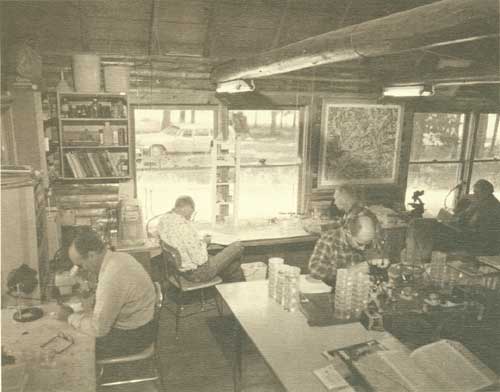
|
| Fig. 23. Research Station Laboratory. From left to right: Charles Thornton, Glenn Noble, Howard Evans, William Thurmond and Margaret Altmann (Herbert Pownall, U. of Wyo. collection). |
Movie company locations played a role in some of the Research Station's early history, i.e., "Big Sky" and "Wide Missouri". Even though dates and names of movies were hard to recall, many associates of the Research Station and Wildlife Park remember the events. An authentic Indian village was constructed on the west side of the Oxbow and was used for several movies. Dressing rooms and trailers of movie personnel were parked in the meadow east of the Station (Altmann 1977). An Indian fight was staged on an island in the Snake River and a large pioneer boat was used by the actors to struggle up the River (the movie viewers never seeing that it was tied to the Jackson Lake Dam) (Clarke 1977). On one occasion, Altmann (1977) recalled how she created havoc when she unknowingly trailed her pack horses and mules through a movie scene.
Clarke was responsible for many important transactions, as well as for improving facilities, during his term as Director. One of his most significant accomplishments, after years of lease negotiations, was the signing of a 20-year Special Use Permit with the Park Service in 1964. This event served as the beginning of a new era of cooperation between the University of Wyoming, the New York Zoological Society and the National Park Service in the Research Station program. The national importance of the era and the contributions of the Station's research program were recognized by Wyoming's Senator Clifford Hansen in his comments entered in the U.S. Senate Congressional Record of March 18, 1968.
Dr. L. Floyd Clarke retired as Director of the Jackson Hole Biological Research Station in 1972. Dr. Oscar H. Paris, the newly appointed Head of the University of Wyoming's Department of Zoology and Physiology, was appointed to the Director's position in 1973 (Fig. 24). The Station continued to operate cooperatively with the New York Zoological Society under the 20-year Special Use Permit with the National Park Service. Paris was instrumental in strengthening the Station's ties with Federal, State and private entities.
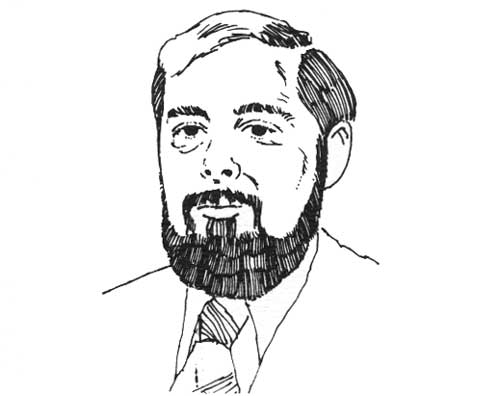
|
| Fig. 24. Oscar H. Paris. |
A main policy of the Station during Paris' 4 years of administration was to obtain information that could be applied to the solution of environmental problems in Grand Teton National Park (Paris 1973). With that objective in mind, he enhanced the value of the scientific contributions and improved the research facilities by the purchase of additional scientific equipment, by upgrading the electrical wiring system in all the buildings and by the winterization of the small laboratory. Although no new buildings were constructed, the researchers' living facilities continued to be improved by Paris.
Paris accepted a position with the U.S. Nuclear Regulatory Commission in Washington, D.C. in August of 1976. Subsequently, he resigned his position as Director of the Research Station and as Head of the University's Department of Zoology and Physiology.
Dr. Kenneth L. Diem, Professor of Zoology and Game Management, Department of Zoology and Physiology, was named Acting Director of the Station in September 1976 (Fig. 25). Shortly after his appointment, important discussions were carried on between University of Wyoming and National Park Service representatives concerning the Research Station program and the physical relocation of the research facilities. As a result, the University of Wyoming and the Park Service approved an agreement to combine the Jackson Hole Biological Research Station and the Northern Rocky Mountain Parks Studies Cooperative Program into a single entity to be known as the University of Wyoming—National Park Service Research Center. Following the signing of the agreement of May 24, 1977, Diem was appointed as Director of the new Research Center.
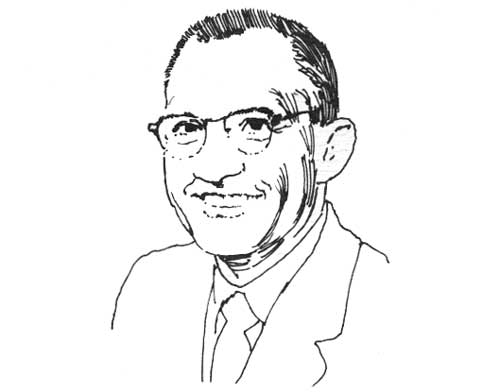
|
| Fig. 25. Kenneth L. Diem. |
The Research Center is governed by an eight-member Steering Committee composed of four National Park Service representatives and four University of Wyoming representatives with administration of the program and the research facilities being carried out by the Director. The institutional arrangement for the sponsorship of the Center changed markedly from that of the old Biological Research Station. The New York Zoological Society discontinued its affiliation. Seeing that the research facilities were firmly established and having accomplished their original objectives for the Jackson Hole Research Station, the Society felt their future efforts should be directed toward the development and improvement of other Society research programs.
Negotiations for new facilities for the Research Center were culminated on July 15, 1977, with the issuance of a 15-year Special Use Permit for the facilities at the National Park Service AMK Ranch properties. The 1977 summer research activities were carried out in the usual manner at the Biological Research Station. Preparation and modification of the facilities at the AMK site were initiated in July 1977 by the University of Wyoming. The moving of property commenced in August and personnel took up residence at the new area during the early part of September.
After working through the fall months with the Director and other personnel to modify the facilities to accommodate researchers, Noble Gregory retired as caretaker January 1, 1978. He was replaced by John B. Adams, who was the former AMK caretaker for the Berol family.
As of July 1, 1978, the physical transfer of the Jackson Hole Biological Research Station and the change of name and program were completed. Some of the old Research Station buildings will be moved to other locations and the remaining facilities will be removed from the site by the summer of 1979. So much of the character of the new Research Center will stem from the strengths of the old Research Station and the environment within which it flourished. One can only hope that the next 30 years will be as kind, as stimulating and as productive as the first 30 years have been. (Fig. 26 and 27).
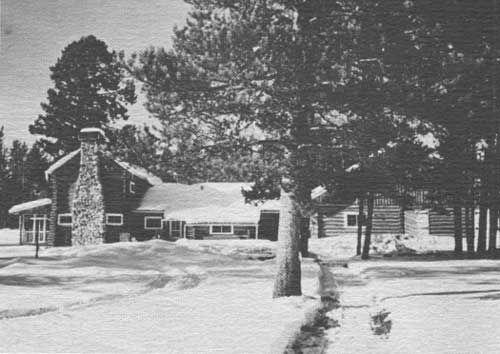
|
| Fig. 26. Johnson Lodge, AMK Ranch (K.L. Diem slide collection). |
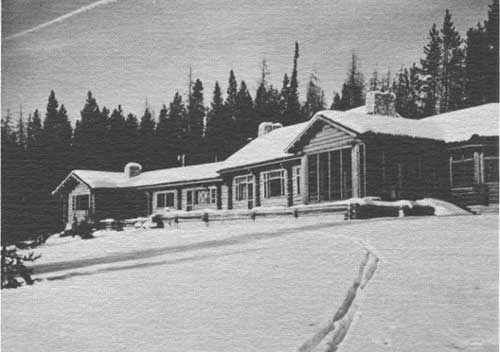
|
| Fig. 27. Berol Lodge, AMK Ranch (K.L. Diem slide collection). |
| <<< Previous | <<< Contents>>> | Next >>> |
research_station/sec5.htm
Last Updated: 11-May-2011